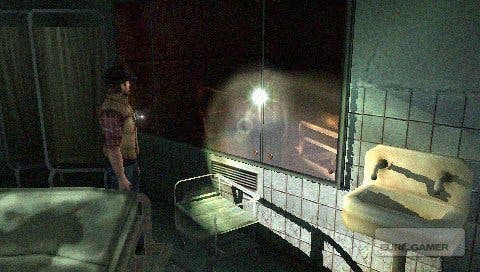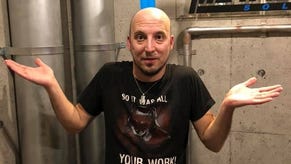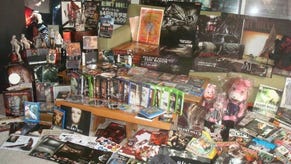Silent Hill Origins
The root of all evil.
"It doesn't matter who I am..."
Yes, that's right - we got to play the game. In fact, we played through roughly the first half hour of Origins, a sequence which introduces the central character, long-distance truck driver Travis O'Grady, and then introduces much of the mystery of Silent Hill itself. In a lengthy and largely interactive intro sequence, Travis is forced to brake hard on a road near Silent Hill when a girl seems to run out in front of his truck. Climbing down from the cab, he sees her run off into the distance (while players are treated to an incredibly creepy shot of her watching him through his rear-view mirror), and runs after her.
You quickly come upon a burning house, and upon navigating it, find the incredibly badly burnt body of a young girl laid out in a ritualistic circle in an upper room - badly burnt, but seemingly still alive. Taking her in your arms, you run out of the house... And promptly pass out, only to wake up on a bench in Silent Hill, surrounded by a thick, creeping fog.
From here on in, we played through the first part of the Hospital area, which is one of the core parts of the game. Progression takes its lead strongly from other Silent Hill titles, with each major building having a map that you fill in with penned annotations as you move through, and a wide variety of somewhat surreal locked-door puzzles to complete in order to progress. In the hospital, for example, we found ourselves collecting the ages of nurses from graffiti on the walls in order to unlock a medical chest, retrieving from it a plastic heart which could be replaced in an anatomical model...

You get the idea. It's solid, enjoyable Silent Hill fare, the sort of puzzles which focus largely on doors and improbably hidden keys. However, Origins has a unique twist up its sleeve, which is revealed early on when you walk into a room with a mirrored wall, and realise that something isn't quite right about the reflection in the mirror...
Silent Hill has always featured the concept of the "Otherworld", a hideous, twisted world of rust, decay and ruin; however, previously access to this alternate world has generally been through plot developments. Origins, however, allows Travis to move between worlds at will whenever he encounters a mirror; by touching the mirror, he moves to the other world. This is essential for solving many puzzles, as the layout of buildings remains broadly the same, but doors may be locked in one reality and unlocked in the other, passages blocked in one but accessible in the other.
In terms of combat, some echoes of the game's one-time obsession with action remain. Travis can pick up a very wide range of items to use as weapons - nowhere near the scale of a game like Dead Rising, but according to Simmons, there are about 50 items in the game which can be used as weapons. These range from guns, knives and swords through to bottles of acid or portable televisions, which can be smashed into enemies for single-shot, high damage attacks.
Where previous Silent Hill games relied on unresponsive, somewhat clumsy combat to emphasise your vulnerability and build tension, Origins has taken a somewhat different tack. Travis is a burly truck driver, and can handle himself to some extent - so combat is a little more responsive and brutal than in other games.

However, this is still no RE4. Monsters who get close to you can grab you and engage in an often horrifying grapple move - a chance, Oertel tells us, to get the player really up close with the hideously disturbing monsters in the game and really freak them out. Even getting a great weapon won't make you invincible; like SH4, the game features a health gauge for weapons. Use them too long, and they'll break, which adds a real note of tension to fights in the game. To top it off, the old SH strategy of legging it past monsters won't always work; some of them move faster than you do, now. Travis may be a tougher cookie than previous SH protagonists, but this is a million miles from the shooting gallery game many feared; the old Silent Hill tension is never far away.
Where much of the development team's efforts have been concentrated is on making Silent Hill work on the PSP. At first, a horror game on a handheld seems like a strange decision - however, Oertel says that the design was inspired by the acknowledgement of how involving and immersive reading a horror paperback can be. "When you're sitting there, in bed, in your room, playing this game - it's an intensely personal experience, much more immersive in some ways than being in your living room with a TV across the room from you," he explains.




